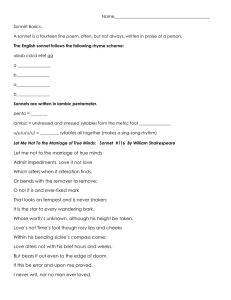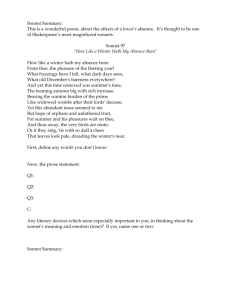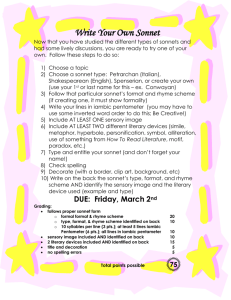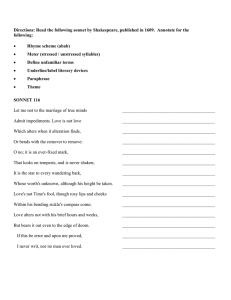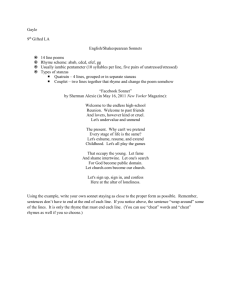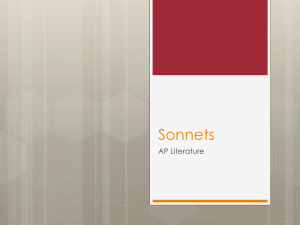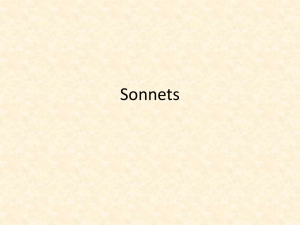Memoir & Other Writing Poetry Exercise #2: Sonnet What is a Sonnet
advertisement
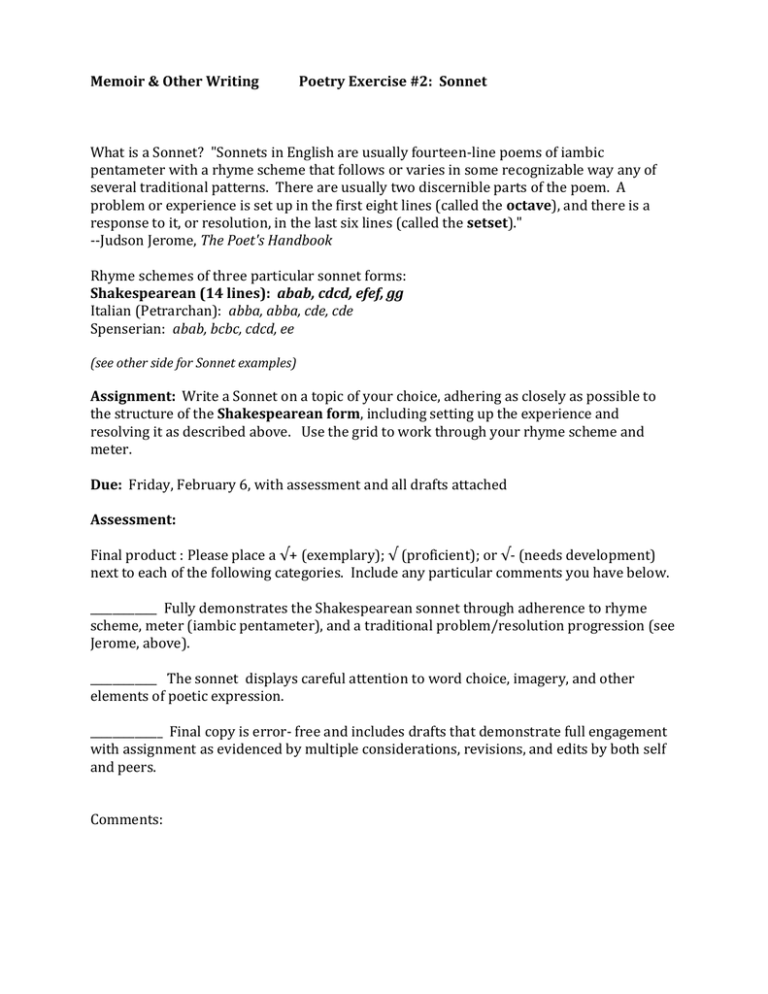
Memoir & Other Writing Poetry Exercise #2: Sonnet What is a Sonnet? "Sonnets in English are usually fourteen-line poems of iambic pentameter with a rhyme scheme that follows or varies in some recognizable way any of several traditional patterns. There are usually two discernible parts of the poem. A problem or experience is set up in the first eight lines (called the octave), and there is a response to it, or resolution, in the last six lines (called the setset)." --Judson Jerome, The Poet's Handbook Rhyme schemes of three particular sonnet forms: Shakespearean (14 lines): abab, cdcd, efef, gg Italian (Petrarchan): abba, abba, cde, cde Spenserian: abab, bcbc, cdcd, ee (see other side for Sonnet examples) Assignment: Write a Sonnet on a topic of your choice, adhering as closely as possible to the structure of the Shakespearean form, including setting up the experience and resolving it as described above. Use the grid to work through your rhyme scheme and meter. Due: Friday, February 6, with assessment and all drafts attached Assessment: Final product : Please place a √+ (exemplary); √ (proficient); or √- (needs development) next to each of the following categories. Include any particular comments you have below. ____________ Fully demonstrates the Shakespearean sonnet through adherence to rhyme scheme, meter (iambic pentameter), and a traditional problem/resolution progression (see Jerome, above). ____________ The sonnet displays careful attention to word choice, imagery, and other elements of poetic expression. _____________ Final copy is error- free and includes drafts that demonstrate full engagement with assignment as evidenced by multiple considerations, revisions, and edits by both self and peers. Comments: SONNET 116 Let me not to the marriage of true minds Admit impediments. Love is not love Which alters when it alteration finds, Or bends with the remover to remove: O no; it is an ever-fixed mark, That looks on tempests, and is never shaken; It is the star to every wandering bark, Whose worth's unknown, although his height be taken. Love's not Time's fool, though rosy lips and cheeks Within his bending sickle's compass come; Love alters not with his brief hours and weeks, But bears it out even to the edge of doom. If this be error and upon me proved, I never writ, nor no man ever loved. William Shakespeare How Do I Love Thee? (Sonnet 43) How do I love thee? Let me count the ways. I love thee to the depth and breadth and height My soul can reach, when feeling out of sight For the ends of being and ideal grace. I love thee to the level of every day’s Most quiet need, by sun and candle-light. I love thee freely, as men strive for right. I love thee purely, as they turn from praise. I love thee with the passion put to use In my old griefs, and with my childhood’s faith. I love thee with a love I seemed to lose With my lost saints. I love thee with the breath, Smiles, tears, of all my life; and, if God choose, I shall but love thee better after death. Elizabeth Barrett Browning Sonnet All we need is fourteen lines, well, thirteen now, and after this one just a dozen to launch a little ship on love's storm-tossed seas, then only ten more left like rows of beans. How easily it goes unless you get Elizabethan and insist the iambic bongos must be played and rhymes positioned at the ends of lines, one for every station of the cross. But hang on here while we make the turn into the final six where all will be resolved, where longing and heartache will find an end, where Laura will tell Petrarch to put down his pen, take off those crazy medieval tights, blow out the lights, and come at last to bed. Billy Collins
